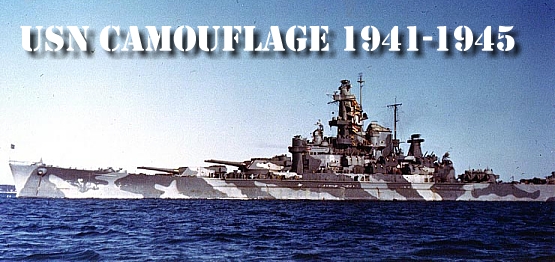The
Development of Naval Camouflage 1914 – 1945
Part III: British Camouflage in World War II
By
Alan Raven
(Article
reprinted courtesy of Plastic Ship
Modeler Magazine issue #97/1)
deck
color were left to the person responsible for painting the ship.
Other
horizontal surfaces (e.g. turret roofs). Very little information available on
this point, but the most common color was probably 507A.
Athwartship
vertical surfaces: Varied according to design. Where a light type was used, it
was usually 507C or MS 4A. Where a darker style was used, sometimes B5. The
above colors only apply when the pattern is the same port and starboard. When
the pattern is different from port to starboard, the connecting vertical
surfaces should be the same as the adjacent surfaces and the two should meet at
the center with a flowing line.
Countershading
(Light type): The following are painted white.
A.
Underside of blast shields,
B.
Underside of flag decks.
C.
Underside - Pom-Pom decks, other gun platforms and other horizontal
projections.
D.
Undersides of ship’s boats.
Masts:
Usually the same color as adjacent vertical surfaces.
Topmasts:
Either 507C or white.
SPECIAL
IDENTITY AND INCLINATION TYPE
Official
in origin (experimental).
Very
little is known about this type. Known to have been used on two ships, LOOKOUT
and LONDON, during the summer of 1942.
Very
distinctive in appearance.
Colors
used: MS 2, BS, MS 4A, 507A, white, and possibly others.
Decks:
No definite information, but probably as Admiralty Light type.
Other
horizontal surfaces: No information available.
Athwartship
vertical surfaces: Same color as adjacent surface.
Countershading:
No definite information available, but probably as Admiralty Light type.
STEPPED
DISRUPTIVE AND CONCEALMENT TYPE (CONTRAST TYPE)
Unofficial
in origin.
Known
to have been used on REPULSE, WARSPITE, and GLASGOW. Designs prepared for
FURIOUS, NELSON, and RODNEY. It is not known if these ships ever carried the
design.
Colors
used: 507A, 507B, and 507C.
Decks:
As peacetime practice.
Countershading:
No evidence that countershading was used.
MOUNTBATTEN
PINK TYPE
Unofficial
in origin.
Believed
used by several ships from cruiser size down during 1940, 1941, and 1942,
Colors
used: Mountbatten Pink (dark), Mountbatten Pink (light).
Decks:
As peacetime practice.
Topmasts:
White. Athwartship vertical surfaces: Mountbatten Pink.
Countershading:
No evidence that countershading was used.
PURKINJE
TYPE
Official
in origin (experimental),
Believed
only worn by the cruiser BERWICK for experimental purposes in 1941/42.
Colors
used: Berwick Blue, 507A, 507C, and possibly Mountbatten Pink.
Decks:
Wood - natural, steel - 507A.
Turret
roofs: Early 1941 - Berwick Blue, late l941 - 507C.
Athwartship
vertical surfaces: Disruptive pattern of Berwick Blue and 507C.
Countershading:
None.
1942
WESTERN APPROACHES TYPE
Official
in origin.
Used
by hundreds of ships from destroyer size down.
Colors
used: Western Approaches Blue, Western Approaches Green, and white.
Decks:
Areas laid with wood, asphalt, semtex, or corticene, should be left in their
natural colors. Steel deck areas were painted MS 2.
Athwartship
vertical surfaces: White.
Countershading:
Extensive use was made of countershading when Western Approaches camouflage was
used. The following surfaces should have been painted white:
A.
Undersides of blast shields, flag decks, boats, Pom-Pom decks, and other
platforms.
B.
After side of bridge.
C.
Lockers, vents, davits, etc.
D.
Whole of after blast screen.
E.
Darken ship screens, canvas covers to reels, etc.
F.
Lower 1/3 of gun barrels, searchlights, etc.
G.
Both masts (if two carried), and crow’s nest.
H.
Insides of gun shields.
I.
All stanchions and other small fittings on deck.
The
camouflage was always taken never the boot topping, down to the waterline.
1942
ADMIRALTY LIGHT DISRUPTIVE TYPF
Official
in origin.
Used
extensively by all small ship classes during 1942 and into late 1943.
Colors
used: MS 1, MS 2, MS 3, MS 4, MS 4A, 507A, 507C, and BS.
Decks:
Steel areas either 507A or MS 2. Decks laid with wood, semtex, asphalt, or
corticene stay their natural color.
Athwartship
vertical surfaces: Either MS 4A or 507C.
Countershading:
Paint the following white:
A.
Underside of blast shields, flag decks, boats, Pom-Pom decks and other
platforms.
B.
Lockers, vents, davits, etc.
C.
All darken ship screens, canvas covers for reels, etc.
D.
Lower 1/3 of gun barrels, searchlights, etc.
E.
Masts and crow’s nest.
F.
Insides of gun shields.
G.
Stanchions and other small fittings on upper deck.
The
camouflage was always taken over the boot topping. Down to the waterline.
1942
ADMIRALTY DARK DISRUPTIVE TYPE (Class designs for small ships)
Official
in origin.
Used
by only a few vessels during 1942.
Colors
used: MS 1, MS 2, MS 3, MS 4, MS 4A, S07A, 507C, and B5.
Decks:
Steel areas MS 1, Wood, semtex, asphalt, and corticene areas are left in their
natural colors.
Countershading:
Paint the following white: Undersides of blast shields, flag decks, boats,
Pom-Pom decks and other platforms.
1943
WESTERN APPROACHES TYPE
Official
in origin.
Used
by hundreds of ships from destroyer size down.
Colors
used: B55 and white.
Decks:
Steel areas are painted B30. Areas of wood, semtex, corticene, and asphalt are
left their natural color.
Other
horizontal surfaces: These should be painted l/2 the reflectance factor of the
adjacent vertical surface color. Example: if a gun turret is painted B55, then
the roof should be painted B30 (see table).
Athwartship
vertical surfaces: Use same color as adjacent vertical surface except rear of
bridge where white should be worn.
Countershading:
Same as for 1942 Western Approaches type.
[ Back Page ] [ Home ] [ Table of Contents ] [ Next Page ]
| 